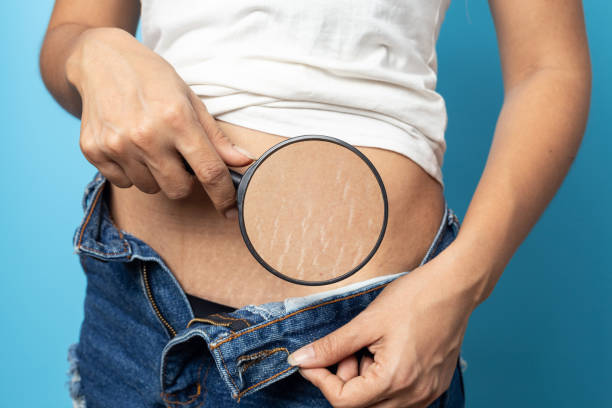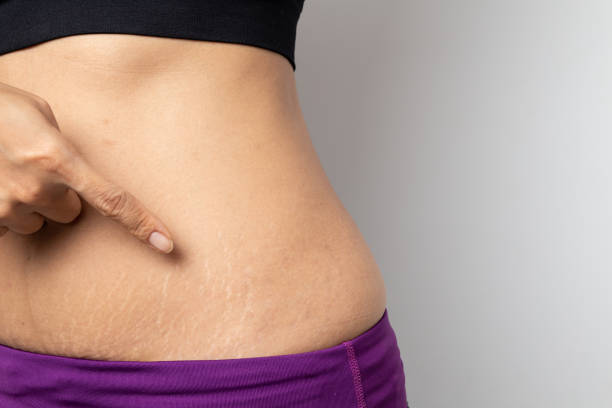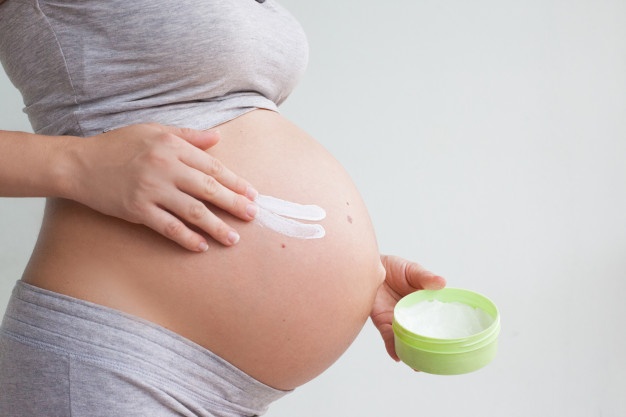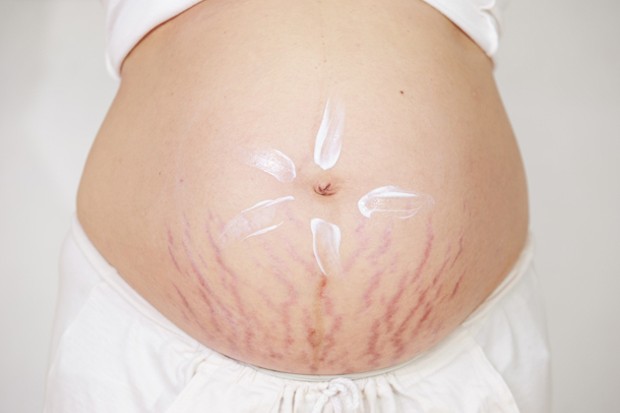Your body can adapt to massive changes, but that doesn’t mean those changes won’t leave a scar. Stretch marks are a phenomenon widespread among pregnant women. But what are their fundamental causes? Is there any way to treat or even prevent them?
To get you out of this trouble, in this article, we will discuss:
- What are stretch marks?
- When do stretch marks appear during pregnancy?
- What causes stretch marks during pregnancy?
- How to treat pregnancy stretch marks
- How to prevent stretch marks during pregnancy
So let’s get straight into it!
What Are Stretch Marks?
Stretch marks happen when your body expands faster than your skin can keep up with. It causes the elastic fibres just under the skin’s surface to break, resulting in stretch marks.
Initially, itchy, thin, and pink in colour, stretch marks typically appear on your skin as bands of parallel lines. From purple to bright pink to light grey, these lines are of various colour and texture than normal skin. They usually appear after a sudden change in your weight or during or after pregnancy.
You can have stretch marks just about anyplace, but most commonly, they appear on the stomach, breasts, upper arms, thighs, and buttocks. However, there is some variation in appearance from person to person.
Research shows that women with greater weight gain, higher body mass index before pregnancy, and a larger abdominal circumference are particularly susceptible to stretch marks. Other contributing factors may also include age, family history, and whether you’re carrying twins.
Although they influence physical appearance to some extent, stretch marks aren’t dangerous, and they often disappear over time.
Are Pregnancy Stretch Marks Permanent?
As stretch marks are a form of scarring, they can never be removed from your skin completely. But they have been known to fade over time (about six to 12 months after childbirth), and certain treatments make them less noticeable.
The pigmentation fades, and they generally become lighter than the surrounding skin (the colour will vary depending on your skin colour), but their texture will remain the same.
When Do Stretch Marks Appear During Pregnancy?
Pregnancy stretch marks are common in the abdominal region as the skin in this area undergoes the most dramatic expansion. They will become increasingly noticeable as your baby bump continues to grow.
Moreover, pronounced weight gain and skin stretching usually occur in the legs and thighs during pregnancy. That is why stretch marks often appear on the inner and upper thighs and behind the knees.
Usually, most pregnant women spot stretch marks when they are somewhere around the sixth or seventh month pregnant (think of stretch marks as modern art for your baby bump). In rare cases, they may present themselves as soon as the pregnant mother’s abdomen starts to grow.
Causes Of Stretch Marks During Pregnancy
There are various reasons for stretch marks to form while you are carrying your baby. Common causes of skin stretching include:
- Elastin and collagen: These proteins promote and maintain your skin’s resilience and elasticity. Pregnancy alters these proteins, upping your skin’s sensitivity.
- Hormones: Fluctuations in hormone levels during pregnancy also play a crucial role in forming stretch marks.
- Physical stretching: Expansion of the skin and weight changes occur in the second trimester of pregnancy. Since these are sudden changes, the skin around the breasts, abdomen, buttocks, and thighs do not have sufficient time to adjust, leading to a rupturing of the skin’s surface.
How To Treat Pregnancy Stretch Marks?
Like any scar, stretch marks are permanent, but few products serve as a remedy for stretch marks. However, it’s essential to understand that no single treatment works for everyone, and many products don’t seem to work at all.
Note: Some products contain ingredients, such as retinol, that can harm your baby. So you should not use these products during pregnancy, but only after your body’s fully healed and your doctor gives the green light.
Stretch Mark Creams, Gels, And Lotions:
Researchers have studied many creams, lotions, and gels sold to treat stretch marks and have discovered some helpful hacks. If you want to try one of the recommended products to fade stretch marks, make sure to:
- Use the product on early stretch marks. Treatment seems to have little or no effect on mature stretch marks.
- Gently massage the product into your stretch marks to make it more effective.
- Apply the product daily and for weeks till you see results.
Procedures That Dermatologists Perform:
Following are the methods Dermatologists use to make stretch marks less noticeable:
- Laser therapy
- Radiofrequency
- Microdermabrasion
- Ultrasound
- Chemical peel
Make sure to consult a dermatologist. They can tell you if any of the previously mentioned treatments would be suitable for you, given your age, health, and how long you’ve had the stretch marks.
Tip To Prevent Stretch Marks
As mentioned before, pregnancy stretch marks can happen by sudden weight gain and skin expansion. However, by taking certain precautions, you may be able to reduce the effects on your body. Consider doing the following:
Apply Natural Creams
Creams containing jojoba oil, hyaluronic acid, aloe vera, and shea butter could help prevent pregnancy stretch marks. Use twice a day, starting with the third month of pregnancy.
Remember that various products might be required to treat different areas of the body.
Stay Hydrated
Dehydrated skin is more prone to forming stretch marks. So you have to drink plenty of fluids in order to keep your skin soft, supple, and elastic.
Eat A Balanced Diet
Another important thing is to eat a balanced diet. Incorporate oranges, tomatoes, spinach, cauliflower, broccoli, and other leafy greens into your meals. Also, make sure your diet includes foods rich in:
- vitamin C
- vitamin D
- vitamin E
- zinc
- protein
By maintaining a healthy and well-balanced diet, you can add those pregnancy pounds at a slower, steadier rate. As a result, it’ll reduce the chances of forming pregnancy stretch marks in the process.
Do Light Exercise
Stay active to avoid huge fluctuations in your body weight. Also, regular exercise boosts blood circulation to your skin, making it less vulnerable to damage.
Conclusion
The development of pregnancy stretch marks may be bothersome, but there are a few steps you can take to prevent and minimise their appearance. But remember to consult your doctor before starting any treatment.





Recent Comments